In 2004, a group of families in the United States came together to share their stories of loss. They were united by preventable tragedy: each had suffered the death of a loved one to flu, or had watched their child endure severe complications following influenza infection.
Along with becoming a source of emotional support for one another, the families began discussing what could be done to help others to avoid suffering the same fate. The network of parents founded Families Fighting Flu (FFF).
‘Our founding families were shocked that their child could be lost to the flu ‒ and shocked that there’s a preventative vaccine that may have saved their lives,’ says Michele Slafkosky, Executive Director of FFF. ‘They decided to share their stories so that others would appreciate the seriousness of influenza and know that they can prevent it.’
Decision-makers listened too. The Centers for Disease Control (CDC) Advisory Committee on Immunization Practices (ACIP) expanded its flu vaccine recommendation in 2006 to include children aged six to 59 months. This was extended in 2008 to all children up to 18 years.
By that time, FFF was a registered charity and had become a highly professional organisation, running public awareness campaigns and working with parent-teacher organisations to put the spotlight on childhood flu vaccination. They continued to attract new members, many of whom had lost a loved one to complications of flu.
In the wake of the 2009-2010 H1N1 flu pandemic, the CDC reviewed its recommendations for flu vaccination which, by then, included older people, pregnant women, those with chronic diseases, and people who live with or provide care for individuals in risk groups.
FFF had a clear message: simply offer flu vaccines for all.
In 2010, with a firm nudge from FFF, the CDC made a landmark decision to issue a ‘universal recommendation’ for flu vaccination to include all individuals six months of age and older.
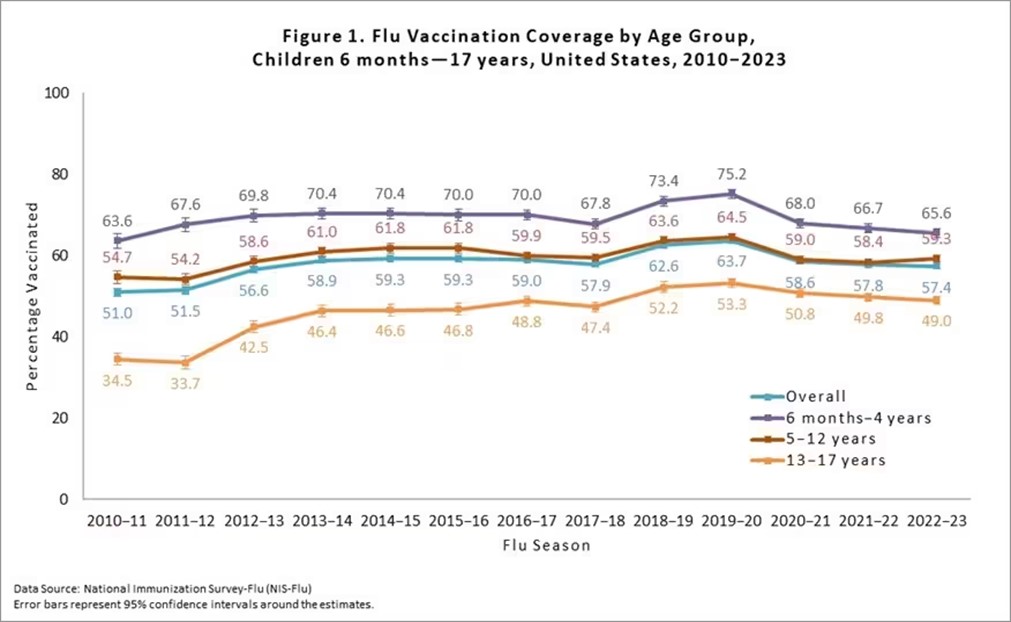
As Dr Litjen Tan of the Immunization Action Coalition told Vaccines Today back in 2012, the universal recommendation sends a clear and simple message: ‘In 2009, we had about 18 target groups covering 85% of people…Our healthcare providers said This is just too complicated. So when we stepped back and looked at it, we took the pragmatic step to say everyone over six months of age should be vaccinated.’
The FFF members who had worked hard to put flu vaccination on the public agenda, enjoyed a bittersweet moment, celebrating the fact that others would be spared complications from flu, but wishing the change had come earlier. ‘Our goal now is to increase uptake,’ says Michele. ‘We want to ensure access so that people can choose to have this recommended vaccine. We want more lives to be saved and fewer people hospitalised.’
Where do children have their flu vaccine?
CDC data show that most children who have the flu vaccine have it at their doctor’s office. A small but rising number visit the pharmacy, with lower numbers attending clinics, hospitals, schools and elsewhere for their annual shot.
‘Pharmacists are anxious to do more, but the rules vary from state to state,’ says Dr Jeb S Teichman, Chief Medical Officer at Families Fighting Flu. ‘Paediatricians are very comfortable delivering vaccines to children, whether that’s against flu or other preventable diseases such as measles.’
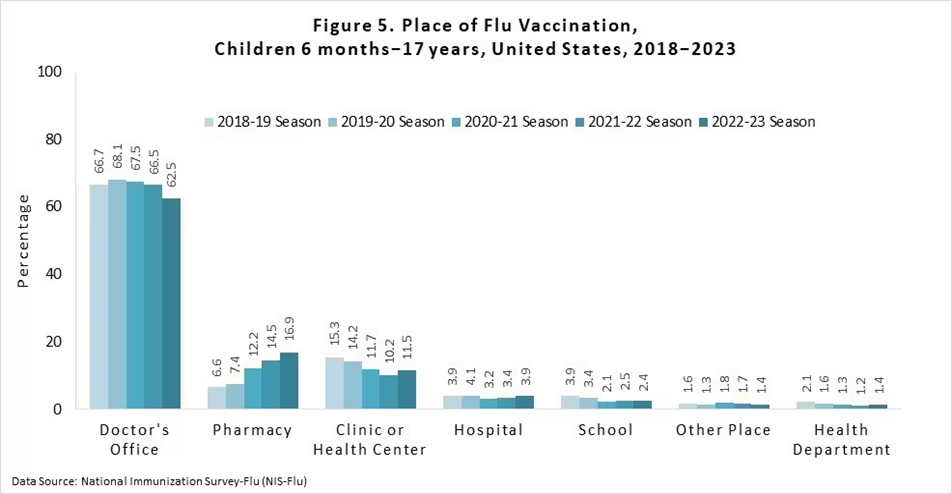
There are also wide variations between states, with vaccination rates for children in some states passing the 75% mark (Massachusetts, Rhode Island and the District of Columbia), while others are below 45% (Mississippi, Montana, Nevada and Oklahoma).
This can be attributed to a variety of factors, including how states procure vaccines and where they are delivered, but it may also be a function of poverty, state legislation, and vaccine acceptance ‒ which has become increasingly political since the COVID-19 pandemic.
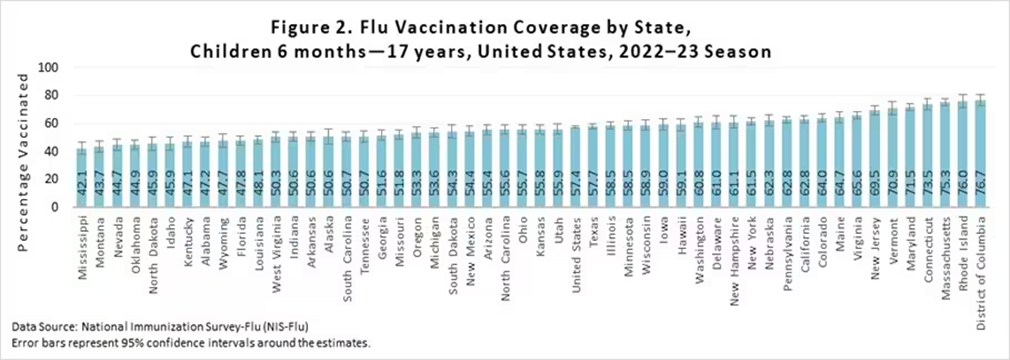
For children and adults alike, the key, says Dr Teichman, is to remove barriers to vaccination, avoid asking people to pay out of pocket, and ensure that vaccination data is recorded in state databases.
The question of who pays is a complex one in the US. For those with insurance, vaccines recommended by the CDC are typically covered within a year of getting the green light from experts. Those with limited means are offered vaccines via Medicaid, while older people are covered by Medicare.
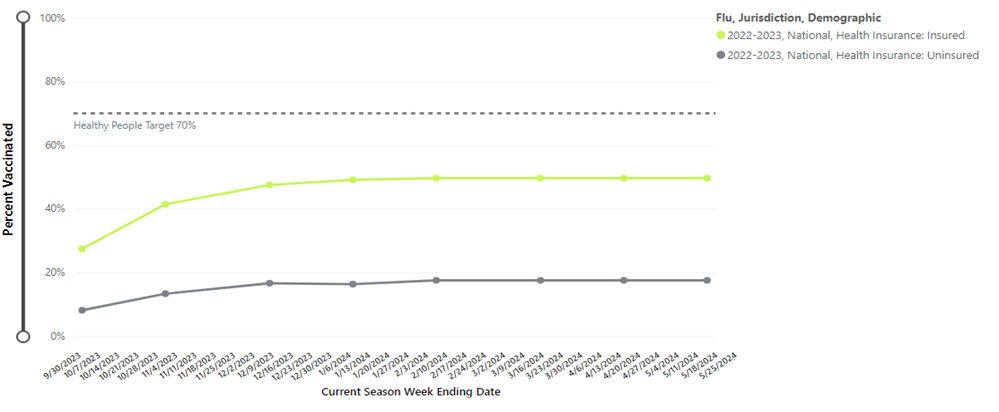
A small number of people who are uninsured or underinsured can fall through the cracks, leaving them with a hefty bill if they want to be protected, but almost everyone in the US can now avail of free flu vaccination.
‘For children who are uninsured or underinsured, the Vaccines for Children (VFC) program provides all ACIP recommended vaccines free of charge,’ Dr Teichman explains. ‘When provided in a doctor’s office, there can be a small charge for administration of the vaccine. The over 18 year age group who are uninsured can usually get a flu shot through their local health department and what they have to pay, if anything, will vary greatly.’
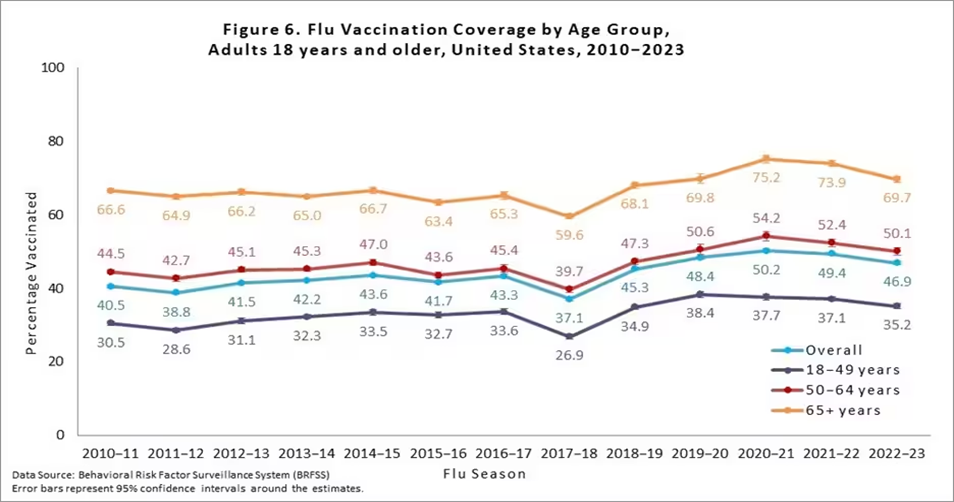
Despite a clear universal recommendation for everyone older than six months, and improved access to vaccination for most, there are gaps in uptake among adults. In particular, flu vaccination rates among younger adults, aged 18-49, have bounced around the 30% mark, hitting 35% last year.
‘For those who are 65 and older, the rates are pretty good, but there’s a long way to go in other groups. Less than one third of pregnant folks get the flu vaccine, and fewer than 50% of those aged 18-64 are vaccinated,’ Dr Tecihman says. ‘We are concerned about a decline in all age groups since COVID.’
The key is to improve vaccination and, for those who are infected, to ensure early access to testing so that they can be treated swiftly. ‘Vaccinate. Test. Treat. That’s the message,’ he says.
Dr Teichman’s family story
Jeb Teichman is a doctor who has worked as a paediatrician and in Kentucky’s Medicaid program which pays for health services, including vaccines, for some children. Given his experience in frontline medical care and in navigating the sometimes complex US health insurance system, he is well placed to serve as a director of Families Fighting Flu.
But that’s not the only reason he does it.
In November 2019, Jeb’s son, Brent died of complications of flu. He was 29 years old. The family chose to share their story through Families Fighting Flu to encourage other young adults to have their shot.
‘I miss my son Brent every day,’ says Jeb. ‘He was in the prime of his life. As a paediatrician and father, I reminded Brent to get his flu shot each year. And while it was on his to-do list, like many people his age, getting vaccinated wasn’t a top priority.’
‘When you are young, you feel invincible. Most young people don’t worry about getting sick, especially with “just the flu.” But as my family knows all too well, the flu can take the life of healthy young adults just as it can for people of all ages. In fact, in 2019, the CDC reported 2,669 flu-related deaths for adults 18-49 years old. That’s 2,669 deaths that perhaps could have been prevented with vaccination.’
Read about Brent here and more of Dr Jeb Teichman’s testimonial here




